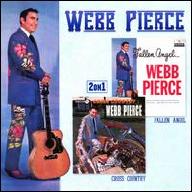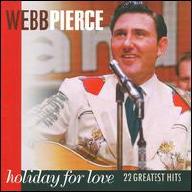As a child in West Monroe, LA, Pierce became infatuated with Gene Autry films and his mother's hillbilly records, particularly those of Jimmie Rodgers and various Western swing and Cajun groups. He began to play guitar before he was a teenager. At the age of 15, he was hired as a singer by Monroe's KMLB. During World War II, Pierce enlisted in the Army. While he was in the service, he married Betty Jane Lewis; their wedding was in June of 1942. After he was discharged, Webb and his wife moved back to Monroe, but by 1944 he moved to Shreveport. Getting a job at Sears Roebuck, Pierce began singing on radio stations, nightclubs, and dances with Betty Jane. At first, they were featured on an early morning radio show on KTBS, while they would perform in the evening at clubs. It took them five years before they were noticed by the industry. In 1949, the California-based 4 Star Records signed the duo under separate recording contracts. Webb signed under his own name, while his wife was signed for duets with her husband under the name Betty Jane and Her Boyfriends. However, success didn't come to the duo -- it only came for Webb; in the summer of 1950, the couple divorced.
In late 1949, Pierce accepted a spot on the Louisiana Hayride, a radio program on KWKH that was instrumental in launching the careers of many country artists. Webb began to assemble a band of local Shreveport musicians, which included recruiting pianist Floyd Cramer, guitarist/vocalist Faron Young, bassist Tillman Franks, and vocalists Teddy and Doyle Wilburn. The Wilburns and Franks all wrote songs, which provided the basis for Webb's initial set list. Pierce also founded a record label called Pacemaker and Ark-La-Tex Music, a publishing company, with Horace Logan, the director of the Louisiana Hayride. On Pacemaker, Pierce made several records between 1950 and 1951. They weren't designed to be big sellers -- they were created with the intent of attracting radio play around Louisiana. In 1951, he was able to get out of his 4-Star contract and Decca Records signed him immediately. Webb's second single, Wondering, became his breakthrough hit, climbing to number one early in 1952. After the single became a hit, Pierce left Louisiana for Nashville, where he met and married his second wife, Audrey Greisham. In June of 1952, he had his second number one single with That Heart Belongs to Me. The following September, the Grand Ole Opry needed to fill the vacancy left by the firing of Hank Williams, so they invited Pierce to join the cast. After Williams' death, Pierce became the most popular singer in country music. For the next four years, every single he released hit the Top Ten, with a total of ten reaching number one, including There Stands the Glass (1953), Slowly (1954), More and More (1954), and In the Jailhouse Now (1955).
Pierce and Opry manager Jim Denny formed Cedarwood Music, a music publishing company, in 1953; later, the pair would invest in radio stations together. Their business ventures were not looked upon kindly by the Opry superiors, and they began pressuring the duo to cease any outside interests. At the same time, Pierce was growing tired of being confined to the Grand Ole Opry -- he thought he wasn't being treated with the respect a star of his stature deserved, and he wanted to be able to partake in the lucrative financial rewards that came with touring. Pierce left the Opry in 1955 and began appearing on #Ozark Jubilee, a television program on the ABC network. He left #Ozark Jubilee in 1956 and returned to the Opry but left for good the following year.
Pierce continued to have hits until the end of the '50s, but he did take a significant dip in popularity after rock roll's arrival in the late '50s. Nevertheless, Pierce stayed on the charts, primarily because he kept in close touch with DJs across the country, which meant that he was able to keep his streak of 34 consecutive Top Ten hits running into 1957. For a while, Pierce tried to keep up with rock roll, covering the Everly Brothers and recording pseudo-rockabilly numbers. Once those proved unsuccessful, he stuck with honky tonk and continued to rack up Top Ten hits right through 1964.
By 1965, the country-pop leanings of the Nashville Sound had pushed honky tonk from the top of the country charts. Pierce remained a star, but he simply didn't have many big hits in the latter half of the '60s -- the most notable was Fool Fool Fool in 1967. Since his music had faded from the spotlight, he became known for his excessive lifestyle. Instead of indulging in intoxicants, Webb indulged in material items. Pierce had Nudie Cohen, a Hollywood tailor famous for his custom-made flamboyant clothing, line two Pontiac convertibles with silver dollars. He built a guitar-shaped swimming pool at his Nashville home. The swimming pool became a popular tourist attraction -- nearly 3,000 people visited it each week -- causing his neighbors, led by Ray Stevens, to file a legal suit against Pierce in order to prevent visitors from coming into their neighborhood.
Throughout the '70s, Pierce continued to record, but most of his income came from his highly lucrative financial investments. Pierce left Decca Records in 1975, making a handful of records for Plantation Records that didn't experience much chart success. His last hit came in 1982, when his duet on In the Jailhouse Now with Willie Nelson scraped the bottom of the country charts.
Despite all of his success, Pierce was never inducted into the Country Music Hall of Fame during his lifetime; it's likely that the members never forgave him for his rejection of the Grand Ole Opry and the Nashville industry. Pierce died of pancreatic cancer on February 24, 1991. Just months before his death, he didn't receive enough votes to be inducted into the Hall of Fame. Nevertheless, his career stands as one of the most successful in the history of country music. ~ Stephen Thomas Erlewine, Rovi


















